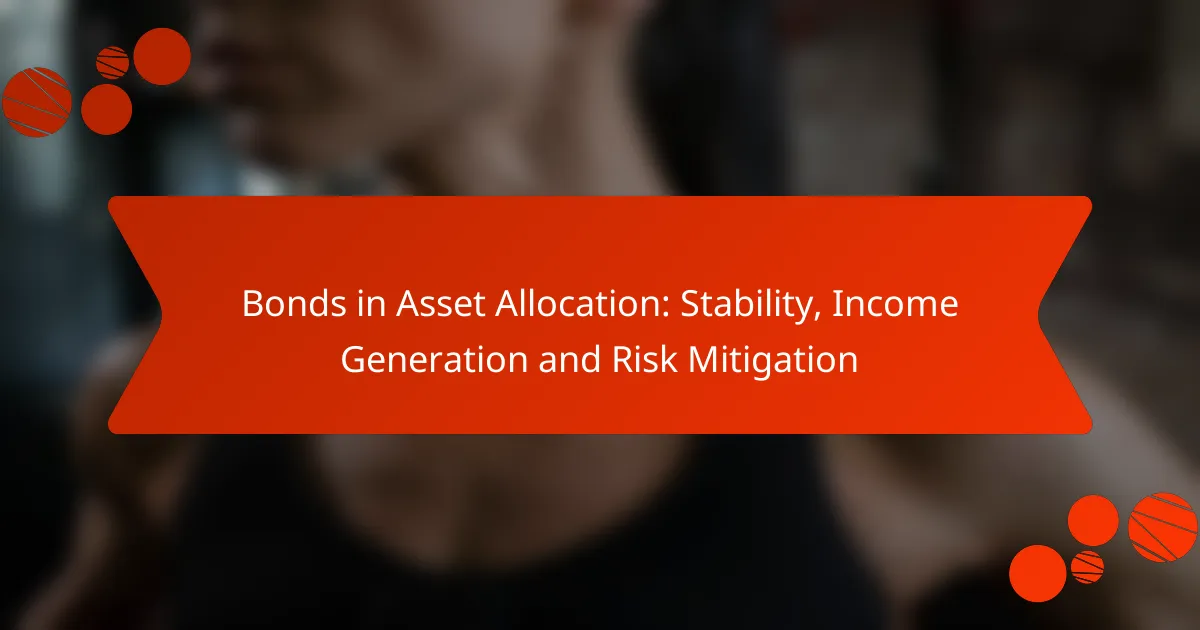Bonds are essential in asset allocation, offering stability, income generation, and risk mitigation for investors. They act as a stabilizing force against market volatility, allowing for a diversified portfolio that balances the inherent risks of equities. By including various types of bonds, such as US Treasury and municipal bonds, investors can secure consistent income while reducing overall portfolio risk.

How do bonds contribute to asset allocation in the US?
Bonds play a crucial role in asset allocation in the US by providing stability, generating income, and mitigating risk. They serve as a counterbalance to equities, helping investors achieve a diversified portfolio that can withstand market fluctuations.
Stability through fixed income
Bonds are considered a stable investment because they offer fixed income over time, which can help protect against market volatility. Unlike stocks, which can experience significant price swings, bonds typically provide predictable returns through regular interest payments.
For instance, U.S. Treasury bonds are backed by the government, making them one of the safest investment options available. Including bonds in an investment portfolio can reduce overall risk and provide a cushion during economic downturns.
Income generation via interest payments
Bonds generate income through interest payments, known as coupon payments, which can be a reliable source of cash flow for investors. This income can be particularly appealing for retirees or those seeking to supplement their earnings.
The interest rates on bonds can vary significantly based on the type and duration of the bond. For example, corporate bonds may offer higher yields compared to government bonds, but they also come with increased risk. Investors should consider their income needs and risk tolerance when selecting bonds for their portfolio.
Risk mitigation against market volatility
Bonds can act as a hedge against market volatility, providing a buffer when stock markets decline. When equities fall, bonds often maintain or increase their value, helping to stabilize an investor’s overall portfolio performance.
To effectively use bonds for risk mitigation, investors should diversify their bond holdings across various types, such as municipal, corporate, and government bonds. This strategy can help spread risk and enhance the stability of returns in uncertain market conditions.

What types of bonds are best for stability?
For stability in an investment portfolio, US Treasury bonds, municipal bonds, and investment-grade corporate bonds are often considered the best options. These bonds typically offer lower risk and can provide consistent income, making them suitable for conservative investors.
US Treasury bonds
US Treasury bonds are backed by the federal government, making them one of the safest investments available. They come in various maturities, typically ranging from 10 to 30 years, and offer fixed interest payments every six months until maturity.
Investors can purchase these bonds directly from the government or through brokers. The interest earned is exempt from state and local taxes, which can enhance overall returns for investors in higher tax brackets.
Municipal bonds
Municipal bonds are issued by state and local governments to finance public projects. They are generally considered stable investments, especially those rated as investment-grade. The interest income from municipal bonds is often exempt from federal income tax and, in some cases, state and local taxes, making them attractive for investors seeking tax efficiency.
These bonds can vary in risk based on the issuer’s creditworthiness and the specific project being financed. Investors should assess the bond’s rating and the financial health of the issuing municipality before investing.
Investment-grade corporate bonds
Investment-grade corporate bonds are issued by companies with strong credit ratings, typically rated BBB or higher. These bonds offer higher yields than government bonds while still maintaining a relatively low risk profile. They are suitable for investors looking for a balance between income and stability.
When considering investment-grade corporate bonds, it’s essential to evaluate the issuing company’s financial health and market position. Diversifying across different sectors can help mitigate risks associated with individual companies.

How can investors use bonds for income generation?
Investors can use bonds to generate income primarily through interest payments, known as coupon payments, which provide a steady cash flow. By incorporating bonds into their portfolios, investors can achieve a more stable income stream compared to stocks, especially during market volatility.
Bond ladders for consistent cash flow
Bond ladders involve purchasing bonds with varying maturities to create a staggered investment approach. This strategy allows investors to receive regular interest payments while minimizing interest rate risk, as some bonds will mature and provide liquidity at different intervals.
For example, an investor might buy bonds maturing in one, three, and five years. As each bond matures, the investor can reinvest the principal into new bonds, maintaining consistent cash flow. This method can help ensure that income is available throughout the investment period.
High-yield bonds for increased returns
High-yield bonds, often referred to as junk bonds, offer higher interest rates compared to investment-grade bonds due to their increased risk of default. Investors seeking greater income potential may consider allocating a portion of their portfolio to these bonds, understanding that they come with higher volatility.
While high-yield bonds can provide attractive returns, it’s crucial to assess the credit quality of the issuers. Diversifying among multiple high-yield bonds can help mitigate risk. Investors should also be prepared for price fluctuations and consider their risk tolerance before investing in this asset class.

What are the risks associated with bond investments?
Bond investments carry several risks that can impact their performance and returns. Understanding these risks is crucial for effective asset allocation and risk management.
Interest rate risk
Interest rate risk refers to the potential for bond prices to decline as interest rates rise. When new bonds are issued at higher rates, existing bonds with lower rates become less attractive, leading to a decrease in their market value.
Investors should consider the duration of their bonds, as longer-duration bonds typically exhibit greater sensitivity to interest rate changes. A general rule of thumb is that for every 1% increase in interest rates, bond prices may fall by approximately 5% to 10%, depending on the bond’s duration.
Credit risk
Credit risk is the possibility that a bond issuer may default on its payment obligations, leading to a loss of principal and interest for investors. This risk varies significantly among different issuers, with government bonds generally considered safer than corporate bonds.
To mitigate credit risk, investors can diversify their bond portfolios across various issuers and sectors. Monitoring credit ratings from agencies like Moody’s or S&P can also help assess the creditworthiness of bond investments.
Inflation risk
Inflation risk is the danger that rising prices will erode the purchasing power of bond interest payments and principal. If inflation outpaces the yield on a bond, the real return can become negative, diminishing the investment’s value over time.
Investors can consider inflation-protected securities, such as Treasury Inflation-Protected Securities (TIPS) in the U.S., which adjust their principal based on inflation rates. Keeping an eye on economic indicators and inflation trends can also aid in making informed investment decisions.

What criteria should investors consider when selecting bonds?
Investors should consider credit ratings, maturity dates, and yield to maturity when selecting bonds. These factors influence the bond’s risk profile, potential returns, and suitability for an investment portfolio.
Credit ratings
Credit ratings assess the creditworthiness of bond issuers, indicating the likelihood of default. Ratings are typically assigned by agencies such as Moody’s, S&P, and Fitch, with grades ranging from AAA (highest quality) to D (default).
When selecting bonds, aim for those rated investment grade (BBB- or higher) for lower risk. However, higher yields often accompany lower-rated bonds, which can appeal to risk-tolerant investors seeking greater income.
Maturity dates
Maturity dates determine when the bond issuer must repay the principal amount. Bonds can be categorized as short-term (1-3 years), medium-term (4-10 years), or long-term (over 10 years), each with distinct risk and return profiles.
Short-term bonds typically offer lower yields but less interest rate risk, while long-term bonds may provide higher yields at the cost of increased volatility. Consider your investment horizon and liquidity needs when choosing maturity dates.
Yield to maturity
Yield to maturity (YTM) represents the total return an investor can expect if the bond is held until maturity, factoring in interest payments and any capital gains or losses. YTM is a critical measure for comparing bonds with different prices and coupon rates.
When evaluating bonds, look for those with a YTM that aligns with your income needs and risk tolerance. A higher YTM may indicate a riskier bond, so balance potential returns with the associated risks.

How do bonds compare to other asset classes in a portfolio?
Bonds generally provide stability and income generation, making them a crucial component of a diversified portfolio. Compared to equities and real estate, bonds typically exhibit lower volatility and can help mitigate risk during market downturns.
Stability and Risk Mitigation
Bonds are often considered a safe haven during economic uncertainty, as they tend to maintain their value better than stocks. This stability is particularly beneficial for conservative investors or those nearing retirement who prioritize capital preservation.
Incorporating bonds into a portfolio can reduce overall risk by balancing out the more volatile asset classes like stocks. A common rule of thumb is to allocate a percentage of your portfolio to bonds that corresponds to your age, promoting a more stable investment approach.
Income Generation
Bonds provide regular interest payments, known as coupon payments, which can serve as a reliable income source. This is particularly appealing for retirees or those seeking to supplement their income without taking on excessive risk.
The yield on bonds can vary significantly based on the issuer’s credit quality and prevailing interest rates. Generally, government bonds offer lower yields compared to corporate bonds, which can provide higher returns but come with increased risk.
Comparison with Other Asset Classes
When comparing bonds to other asset classes like stocks and real estate, it’s essential to consider their risk-return profiles. While stocks can offer higher returns over the long term, they also carry greater risk and volatility.
Real estate can provide both income and appreciation potential, but it requires more active management and can be less liquid than bonds. In contrast, bonds are typically easier to buy and sell, making them a more flexible option for investors looking to adjust their portfolios quickly.

